#Chinese Han Dynasty clothing
Text
[Hanfu · 漢服]The relationship between women in history is not just love rivals,
“but also thousands of years later, everyone knows that it is me and you.”
Let's get to know about them/她们 in China history.
1.【Han Dynasty】:Princess Jieyou (解忧公主) & Feng Liao (馮嫽)
Princess Jieyou (Chinese: 解忧公主; 121 BC – 49 BC), born Liu Jieyou (Chinese: 刘解忧), was a Chinese princess sent to marry the leader of the Wusun kingdom as part of the Western Han Chinese policy of heqin(和亲).
As the granddaughter of the disgraced Prince Liu Wu (劉戊) who had taken part in the disastrous Rebellion of the Seven States,her status was low enough that she was sent to replace Princess Liu Xijun (劉細君) after her untimely death and marry the Wusun king Cunzhou (岑陬).
Jieyou lived among the Wusun for fifty years and did much work to foster relations between the surrounding kingdoms and the Han. She was particularly reliant upon her attendant, Feng Liao, whom she dispatched as an emissary to Wusun kingdoms and even to the Han Court. She faced opposition from pro-Xiongnu members of the Wusun royalty, particularly Wengguimi’s Xiongnu wife. When word came that the Xiongnu planned to attack Wusun, she convinced her husband to send for aid from the Han Emperor. Emperor Wu of Han sent 150,000 cavalrymen to support the Wusun forces and drive back the Xiongnu.
In 51 BCE at the age of 70, Jieyou asked to be allowed to retire and return to the Han. Emperor Xuan of Han agreed and had her escorted back to Chang'an where she was welcomed with honor. She was given a grand palace with servants usually reserved for princesses of the imperial family. In 49 BCE, Jieyou died peacefully.
Feng Liao (馮嫽)
Feng Liao (馮嫽) was China's first official female diplomat,[citation needed] who represented the Han dynasty to Wusun (烏孫), which was in the Western Regions. It was a practice for the Imperial Court to foster alliances with the northern tribes via marriage, and two Han princesses had married Wusun kings.
Feng Liao was the maidservant of Princess Jieyou (解憂公主), who was married off to a Wusun king. Feng herself later married an influential Wusun general, whose good standing with Prince Wujiutu (烏就屠) of the kingdom later proved beneficial to the Han dynasty.
When Prince Wujiutu seized the throne of Wusun in 64 BC, after his father died, there was fear in the Imperial Court of Han that Wujiutu, whose mother was Xiongnu, would allow Wusun to become Xiongnu's vassal.
Zheng Ji, Governor of the Western Regions, recalled that Feng Liao had married into Wusun and with her familiarity of the Wusun customs, she was a prime candidate to persuade Wujiutu to ally his kingdom with Han. Wujiutu acceded and Emperor Xuan of Han (漢宣帝) sent for Feng. He praised her for her judgement and diplomacy, and appointed her as the official envoy to Wusun.
Wujiutu was conferred the title "Little King of Wusun" while his brother, the son by a Han princess, was named "Great King of Wusun". Wusun was divided between the two kings and tensions in that region were eased.
※Xiongnu: Xiongnu: A nomadic tribe that has occupied northern China for a long time. Later it gradually became a state. It harassed the borders of the Han Dynasty for a long time and robbed supplies.
------
With their efforts, the Wusun Kingdom gradually tended to support the Han Dynasty, and the Xiongnu's defeat in China also began.
------
2.【Tang Dynasty】:Shangguan Wan'er(上官婉儿)&Princess Taiping (太平公主)
Shangguan Wan'er/上官婉儿 (664 – 21 July 710) was a Chinese politician, poet, and imperial consort of the Wu Zhou and Tang dynasties. Described as a "female prime minister,"Shangguan rose from modest origins as a palace servant to become secretary and leading advisor to Empress Wu Zetian of Zhou. Under Empress Wu, Shangguan exercised responsibility for drafting imperial edicts and earned approbation for her writing style. She retained her influence as consort to Wu's son and successor, Emperor Zhongzong of Tang, holding the imperial consort rank of Zhaorong (昭容). Shangguan was also highly esteemed for her talent as a poet.Shangguan was also highly esteemed for her talent as a poet. In 710, after Emperor Zhongzong's death, Shangguan was killed during a palace coup that ended the regency of Empress Dowager Wei.
Princess Taiping (太平公主)lit. "Princess of Great Peace", personal name unknown, possibly Li Lingyue (李令月) (after 662 – 2 August 713) was a royal princess and prominent political figure of the Tang dynasty and her mother Wu Zetian's Zhou dynasty. She was the youngest daughter of Wu Zetian and Emperor Gaozong and was influential during the reigns of her mother and her elder brothers Emperor Zhongzong and Emperor Ruizong (both of whom reigned twice), particularly during Emperor Ruizong's second reign, when for three years until her death, she was the real power behind the throne.
She is the most famous and influential princess of the Tang dynasty and possibly in the whole history of China thanks to her power, ability and ambition. She was involved in political difficulties and developments during the reigns of her mother and brothers. Indeed, after the coup against Empress Dowager Wei, she became the real ruler of Tang. During the reign of Emperor Ruizong, she was not restricted by anything, the emperor issued rulings based on her views and the courtiers and the military flattered her and majority from every civil and military class joined her faction, so her power exceeded that of the emperor.
Eventually, however, a rivalry developed between her and her nephew, Emperor Ruizong's son, Crown Prince Li Longji. Both of them were hostile in power-sharing and they fought for the monopoly over power. After Emperor Ruizong yielded the throne to Li Longji (as Emperor Xuanzong) in 712, the conflict came to the political forefront, and openly, the court became a manifestation of conspiracy rather than the administration of the empire; in 713, Emperor Xuanzong, according to historical records, believing that she was planning to overthrow him, acted first, executing a large number of her powerful allies and forcing her to commit suicide.
------
The relationship between Shangguan Wan'er and Princess Taiping has always been written as "enemies" in official history, but with the phrase "千年万岁,椒花颂声", their friendship that has been buried for thousands of years was revealed.
The"千年万岁,椒花颂声" sentence comes from the epitaph written by Princess Taiping for Shangguan Wan'er. The original text is: "潇湘水断,宛委山倾,珠沉圆折,玉碎连城。甫瞻松槚,静听坟茔,千年万岁,椒花颂声”
Translation: Now that you are far away, the sky and the earth will lose their color. I'm afraid that all I can do in the future is to sit and look at the tea tree in front of your tomb. Maybe I can hear your voice again when I stand within an inch of the tomb. But this is a delusion after all, a quiet tomb, no beautiful face, a empty place of death. I hope that in a thousand or ten thousand years, there will still be people like me who remember you.
------
3.【Late Qing Dynasty】:Lü Bicheng(呂碧城) & Qiu Jin (秋瑾)
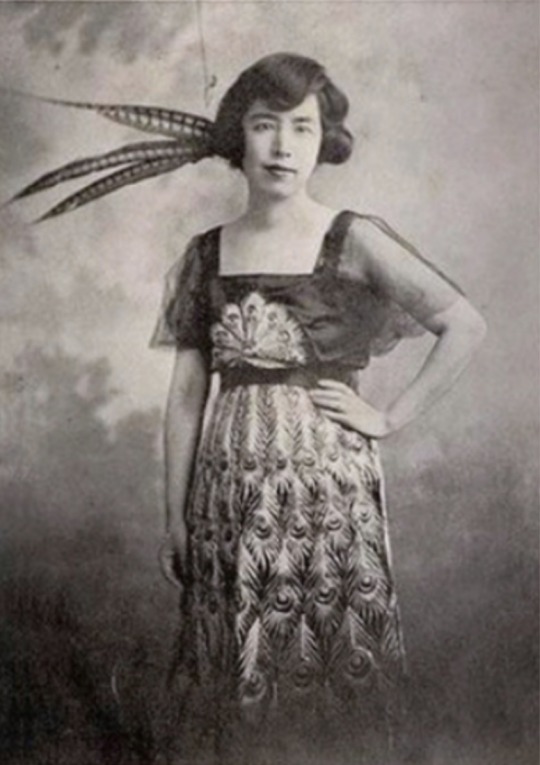
Lü Bicheng(呂碧城)also known as Alice Pichen Lee(1883–1943) was a Chinese writer, activist, newspaper editor, poet and school founder. She has been mentioned as one of the top four women in literature from the early Republic of China.
When she was four, her father retired to Lu'an, Anhui. She lived a life of comfort until the age of 12, when her father died in 1895. Because Lü Fengqi had no male heir, relatives of the Lü lineage contested for his inheritance, and Yan Shiyu and her four daughters were forced to move to Lai'an County to live with her natal family. When she was nine, Lü Bicheng was betrothed to a Wang family, but as her own family fortune declined, the Wang family broke off the marriage contract, giving the young Bicheng the stigma of a "rejected woman". The resulting emotional scar is often considered a major factor in her later decision to never marry.[8] Her widowed mother and the Lü girls were not well treated at the Yan family in rural Anhui. When Lü was 15 or 16, Yan Shiyu sent her to live with her maternal uncle Yan Langxuan (嚴朗軒), who was the salt administrator in Tanggu, the port city outside the northern metropolis of Tianjin. Her sister Huiru also joined her later.
During her stay in Tanggu, Qing China went through the tumultuous period of the failed Hundred Days' Reform of 1898, which brought about increasing awareness of women's education, and the Boxer Rebellion of 1900. In 1904, Mrs. Fang, the wife of her uncle's secretary, invited Lü Bicheng to visit a girls' school in Tianjin, but her uncle prevented her from going and severely reprimanded her. The next day, she ran away from her uncle's home, and took the train to Tianjin with no money or luggage. She wrote a letter to Mrs. Fang, who was staying at the dormitory of the Ta Kung Pao newspaper. Ying Lianzhi, the Catholic Manchu nobleman who founded the newspaper, read the letter and was so impressed by it that he made her an assistant editor. Lü Bicheng wrote a "progressive" ci that she had previously written, set to "A River Full of Red" ("Manjianghong") usually used to express heroic emotions. Ying transcribed the whole song in her diary and published it in L'impartial two days later. At the time, it was sensational for a woman to write for an influential national newspaper such as Ta Kung Pao. She was 21 years old. She used Ta Kung Pao to promote feminism and became a well-known figure.
Lü's ci poetry was published in the newspaper and it was very well received. She was the chief editor of the newspaper from 1904 to 1908. In 1904 she decided to improve education for girls. She had published her thoughts on women's rights and the general editor of the newspaper introduced her to Yan Fu who was an advocate for Western ideas. The Beiyang Women's Normal School was established that same year. At 23 Lü took on the job of principal of the school she had founded two years before. At first this school found it difficult to find girls who qualified for secondary education and students were brought in from Shanghai to make up the numbers.
Lü knew the revolutionary Qiu Jin and they had similar objectives but Lü did not join her in Japan when she was invited as she was unsure whether women should meddle in politics. She was then chosen to be secretary to Yuan Shikai, one of the most powerful people in China. When he set out to declare himself emperor of China she left, like many of his followers, and abandoned him.
--

Qiu Jin (秋瑾)8 November 1875 – 15 July 1907,was a Chinese revolutionary, feminist, and writer.Her sobriquet name is Jianhu Nüxia (Chinese: 鑑湖女俠 lit. 'Woman Knight of Mirror Lake').
Qiu was born into a wealthy family. Her grandfather worked in the Xiamen city government and was responsible for the city's defense. Zhejiang province was famous for female education, and Qiu Jin had support from her family when she was young to pursue her educational interests. Her father, Qiu Shounan, was a government official and her mother came from a distinguished literati-official family. Qiu Jin's wealthy and educated background, along with her early exposure to political ideologies were key factors in her transformation to becoming a female pioneer for the woman's liberation movement and the republican revolution in China.
In the early 1900s, Japan had started to experience western influences earlier than China. As to not fall behind, the Qing government sent many elites to learn from the Japanese. Qiu Jin was one of these elites that got the chance to study overseas. After studying in a women's school in Japan, Qiu returned to China to participate in a variety of revolutionary activities; and through her involvement with these activities, it became clear how Qiu wanted others to perceive her. Qiu called herself 'Female Knight-Errant of Jian Lake' — the role of the knight-errant, established in the Han dynasty, was a prototypically male figure known for swordsmanship, bravery, faithfulness, and self-sacrifice — and 'Vying for Heroism'
Qiu Jin had her feet bound and began writing poetry at an early age. With the support from her family, Qiu Jin also learned how to ride a horse, use a sword, and drink wine—activities that usually only men were permitted to learn at the time.In 1896 Qiu Jin got married. At the time she was only 21, which was considered late for a woman of that time. Qiu Jin's father arranged her marriage to Wang Tingchun, the youngest son of a wealthy merchant in Hunan province. Qiu Jin did not get along well with her husband, as her husband only cared about enjoying himself.While in an unhappy marriage, Qiu came into contact with new ideas. The failure of her marriage affected her decisions later on, including choosing to study in Japan.
While still in Tokyo, Qiu single-handedly edited a journal, Vernacular Journal (Baihua Bao). A number of issues were published using vernacular Chinese as a medium of revolutionary propaganda. In one issue, Qiu wrote A Respectful Proclamation to China's 200 Million Women Comrades, a manifesto within which she lamented the problems caused by bound feet and oppressive marriages. Having suffered from both ordeals herself, Qiu explained her experience in the manifesto and received an overwhelmingly sympathetic response from her readers. Also outlined in the manifesto was Qiu's belief that a better future for women lay under a Western-type government instead of the Qing government that was in power at the time. She joined forces with her cousin Xu Xilin and together they worked to unite many secret revolutionary societies to work together for the overthrow of the Qing dynasty.
Between 1905 and 1907, Qiu Jin was also writing a novel called Stones of the Jingwei Bird in traditional ballad form, a type of literature often composed by women for women audiences. The novel describes the relationship between five wealthy women who decide to flee their families and the arranged marriages awaiting them in order to study and join revolutionary activities in Tokyo. Titles for the later uncompleted chapters suggest that the women will go on to talk about “education, manufacturing, military activities, speechmaking, and direct political action, eventually overthrowing the Qing dynasty and establishing a republic” — all of which were subject matters that Qiu either participated in or advocated for.
Life after returning to China
Qiu Jin was known as an eloquent orator who spoke out for women's rights, such as the freedom to marry, freedom of education, and abolishment of the practice of foot binding. In 1906 she founded China Women's News (Zhongguo nü bao), a radical women's journal with another female poet, Xu Zihua in Shanghai. They published only two issues before it was closed by the authorities. In 1907, she became head of the Datong school in Shaoxing, ostensibly a school for sport teachers, but really intended for the military training of revolutionaries[citation needed]. While teaching in Datong school, she kept secret connection with local underground organization—The Restoration Society. This organization aimed to overthrow the Manchu government and restore Chinese rule.
Death
In 1907, Xu Xilin, Qiu’s friend and the Datong school’s co-founder was executed for attempting to assassinate his Manchu superior. In the same year, the authorities arrested Qiu at the school for girls where she was the principal. She was tortured but refused to admit her involvement in the plot. Instead the authorities used her own writings as incrimination against her and, a few days later, she was publicly beheaded in her home village, Shanyin, at the age of 31. Her last written words, her death poem, uses the literal meaning of her name, Autumn Gem, to lament of the failed revolution that she would never see take place:
秋風秋雨愁煞人
(Autumn wind, autumn rain — they make one die of sorrow)
After Qiu Jin was killed, no one dared to collect her body. Lu Bicheng endured her grief and took great risks to bury her friend. The guarding Qing army learned that the woman who came to collect the corpse was Lu Bicheng, who was famous in China, and they had no choice but to do anything.
Qiu Jin's death caused Lu Bicheng to lose a rare confidant in life. She wrote many poems in memory of Qiu Jin, recalling this like-minded friend.
Later, Lü Bicheng wrote "The Biography of the Revolutionary Heroine Qiu Jin" in English, which was published in newspapers in New York, Chicago and other places in the United States. It caused a great response and not only made many people in the world know about Qiu Jin's legendary story, but also published it in newspapers in New York and Chicago. It also makes people understand the darkness and corrupt social status quo of the Qing Dynasty. Lu Bicheng used a pen of her own to record her friendship with Qiu Jin, and also fulfilled her promise to Qiu Jin to respond with the "battle of words"
————————
📸Video & 🧚🏻 Model:@荷里寒 & @阿时Ashi_
🔗Weibo:https://weibo.com/3618951560/NEZZnpQRq
————————
#chinese hanfu#china history#woman power#woman in history#hanfu#hanfu accessories#hanfu_challenge#chinese traditional clothing#china#chinese#han dynasty#tang dynasty#late qing dynasty#feminism#revolution#漢服#汉服#中華風#girl power#hanfu girl
357 notes
·
View notes
Text

Fooduary Day 10: Dragon's Beard Candy
Happy Lunar New Year!!! This one probably doesn’t seem very obvious but a white-candy version would be terribly unlucky!! (And I need all the luck I can get). So I tried to make the lantern slightly reminiscent of the treat while the character is styled in Han Dynasty fashion. According to the legend-history of dragon’s beard candy it was invented in the Han Dynasty (202 BCE 220 CE) which makes it our oldest dessert yet! And yeah, I went off script for this one. Day 10 was supposed to be Cinnamon rolls but I’m moving some stuff around because I so rarely get the chance to post something to celebrate.
I am the artist! Do not post without permission & credit! Thank you! Come visit me over on: instagram, tiktok or check out my coloring book available now \ („• ֊ •„) /
https://linktr.ee/ellen.artistic
#dragon's beard candy#han dynasty clothing#fooduary#art challenge#historical fashion#ellenart#lnart#character design#digital illustration#historically inspired#fooduary2024#dragons beard#hanfu#happy CNY#happy lunar new year#year of the dragon#chinese new year
355 notes
·
View notes
Photo
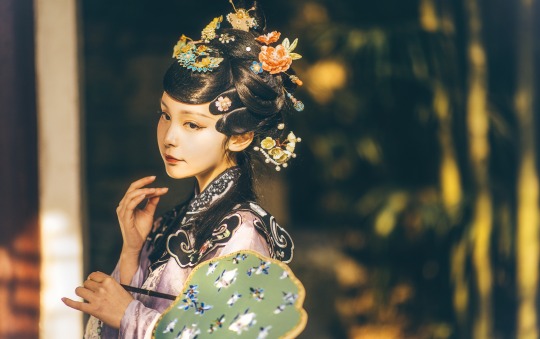

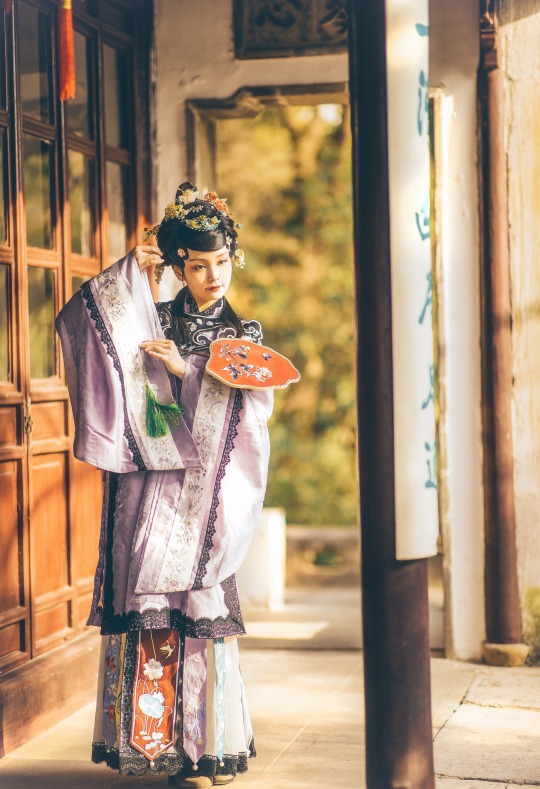

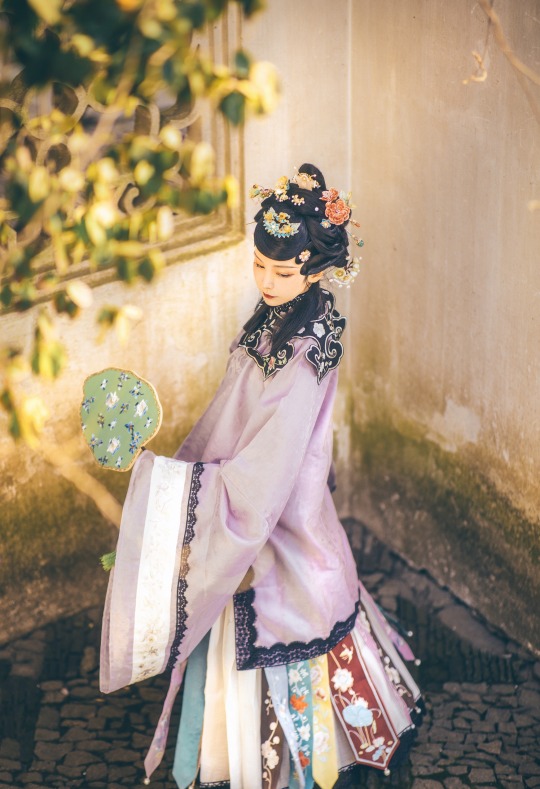
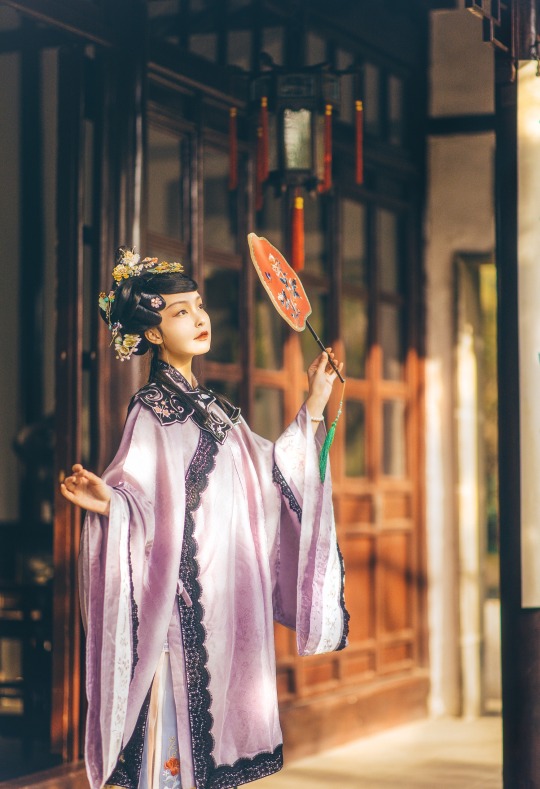

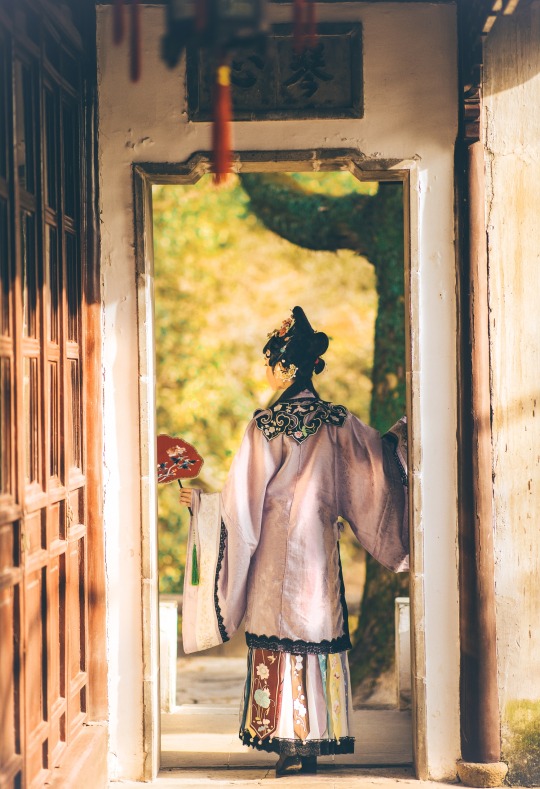

𝒮𝓊𝓃𝓃𝓎𝓊𝒻ℯ𝒾元気姬
#Qing Dynasty#Mamianqun#Qizhuang#Yunjian#Cloud collar#Han women’s clothing of the Qing Dynasty#Manchu Fashion#Chinese Fashion#Fashion
216 notes
·
View notes
Photo
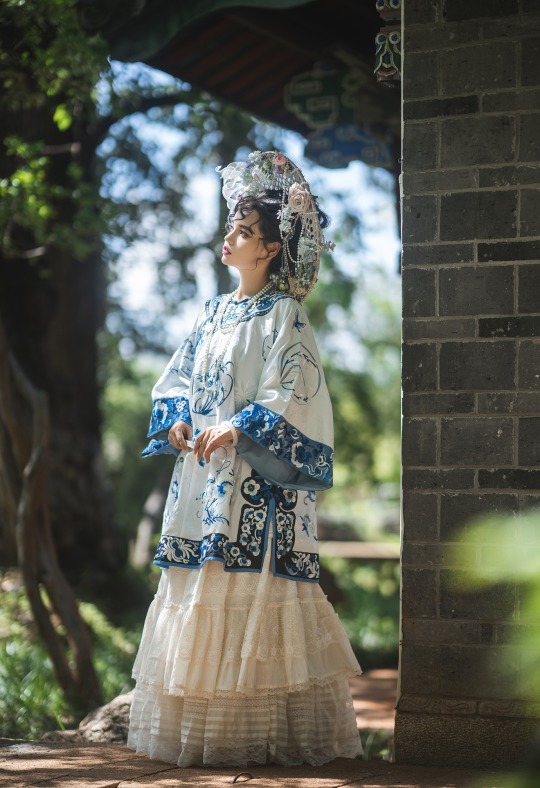




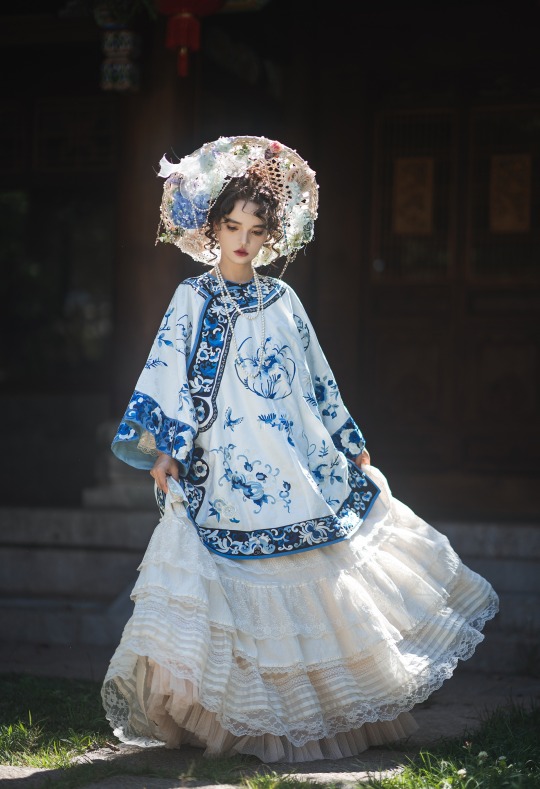
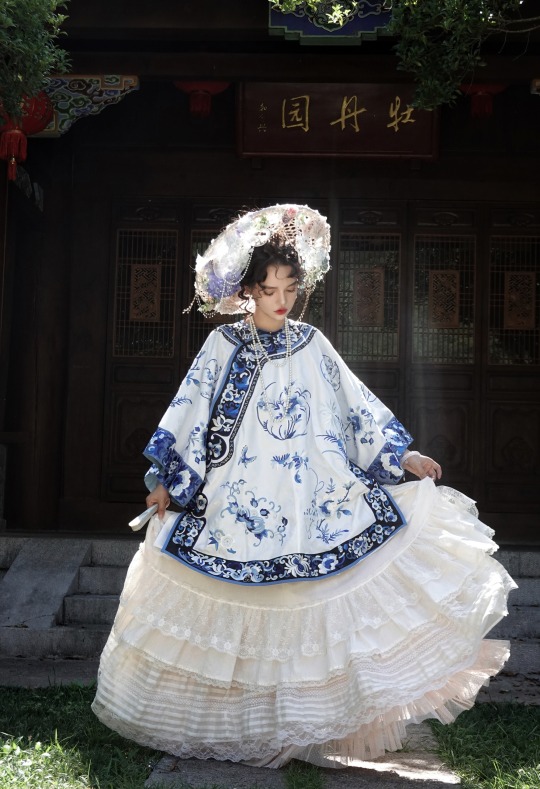

𝒬𝒾𝓏𝒽𝓊𝒶𝓃𝑔/旗装: 花神妙华服
𝑀𝑜𝒹𝑒𝓁: 肉肉馅团子
𝒞𝒶𝓂𝑒𝓇𝒶: 花轮子哥哥
𝑀𝒶𝓀𝑒𝓊𝓅: 蚊𝓌𝓌𝓌桑
150 notes
·
View notes
Photo

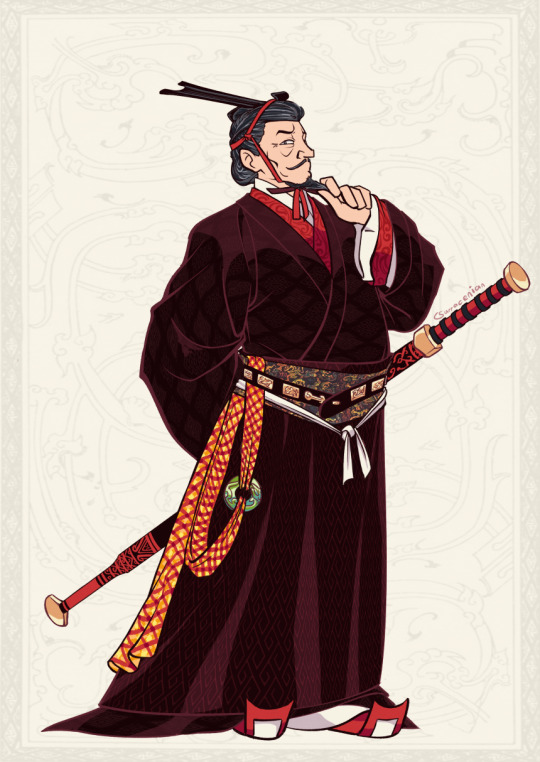
Qin & Han Dynasty Imperials
Contrary to popular belief, Chinese emperors and others in the imperial family would not have worn the more famous ceremonial Mianfu-robes during the Qin and much of Han Dynasty, but the more comparatively austere "Jūnxuán"(袀玄), which was a Qin invention, because they weren't into the Zhou-Etiquette informed Mianfu, as Qin Kingdom then later Empire dedicated its state philosophy to Hanfeizi's Legalism.
Which basically means Every Single Popular Depiction Of Qin Shihuang and Emperor Wu of Han you've likely seen are actually wrong hahaha
(You can read more of the history from my patreon here!)

(references used, more detailed in the patreon post)
#hanfu#chinese history#ancient china#han dynasty#qin dynasty#汉代#秦#historical fashion#chinese clothing
57 notes
·
View notes
Note
Hi Ziseviolet! Do you have any information about the hanfu during the Dynasty Han?
Hi! Thanks for the question, and sorry for taking ages to reply!
Yes I do - for information about the hanfu during the Han dynasty, please check out my Han dynasty tag.
Hope this helps!
#hanfu#han dynasty#history#reference#ask#reply#misssylvertongue#m#s#chinese clothing#chinese fashion#china
6 notes
·
View notes
Text
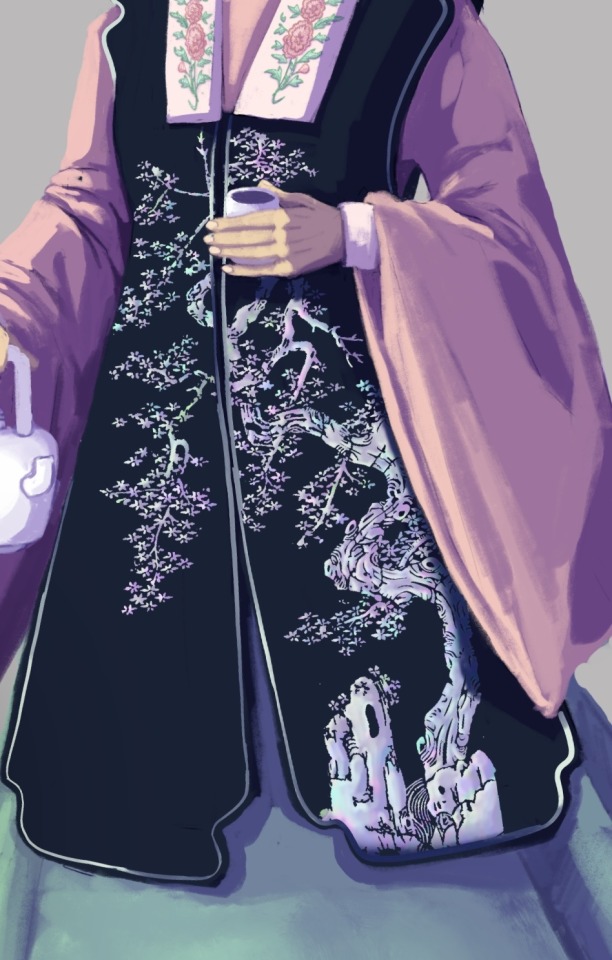
very proud of this
#drawing hanfu for the first time#tried my best to research the period i was going for but who knows how close it is#so just say im taking creative liberties like i always do#jordan talks#there was someone in class talking about hanfu and it took everything in my power to not be like ‘actually’#as if i know much about it#the thing is they seemed to be saying hanfu is exclusive to the han dynasty as a term#which it isnt….. han is referring to the ethnicity here#its ALL traditional han chinese clothing.#the name DOES come from the dynasty but u are misinterpreting the use here idk lmfao#anyways this is based on an piece of laquerware with mother of pearl inlay :)
6 notes
·
View notes
Text
trying to research historical vietnamese clothing lead me down a rabbit hole i wasn't prepared for
#by which i mean i see a lot of people claiming that the vietnamese and the koreans 'stole' chinese hanfu#a few of those people had chinese flags in their usernames or bios but all the comments im talking about are in english#for clarity's sake#they're like posting pictures of old vietnamese and korean art along with chinese art and pointing out the similarities in the clothes#while saying shit like 'the thieving viets stole chinese culture!!'#admittedly im not an expert on east and south east asian history#and i know there's bad blood between them#but i *do* know that china occupied vietnam and korea at different points in their histories#and in vietnam's case it happened in the han dynasty which was like 200 BC to 250 CE#(but not throughout that entire era)#and in both countries china had such a strong influence in the politics and culture#like vietnam used chinese hanzi for writing since the han dynasty and in korea#the chinese language has influenced the korean language since like 100 bce#i mean most korean surnames are classified as sino-korean in origin#i just don't think you can accuse nations of stealing a culture that's been a huge influence on theirs for thousands of years#mickey.txt
2 notes
·
View notes
Text

Notification: The peerless jade fairy of Cang Qiong's Mountain Sect is smiling! Looks like he's easily amused by his disciples' antics...!!! What a surprise!!! +300 Overwhelming Beauty Points!
Ok now for my silly little notes in fashion and other nonsense about this piece:
This is specifically Shen Yuan during the pre-abyss arc, mostly because I have a very, very different interpretation of him when he's already married to Binghe- Empress Shen is a whole other, much more decked out beast I will one day tackle.
His clothes are based on late Qin to early Han dynasty clothes for women, mostly because I can, and it seemed perfect for him; it's completely covered, and thus respectable and elegant! Nothing wrong to see here. It's also tight-er around the legs, which leaves things to the imagination...half of the mountain is definitely thinking about his long, slender, lily-white legs at any given time.
Is it technically crossdressing? Yeah, but it is a shitty Xia-Xia world, who's gonna stop me? Airplane? That guy would be on my side, actually.
The see-through outer robe is a flex, look at all that expensive fabric...just hanging off of him...a rich kid in one life a rich kid in all of them.
Binghe does his hair because he's terrible at it and can only do half-updo's or ponytails, he's too distracted by the mere thought of touching Shizun's hair to stop and think why Shen Qingqiu can't do it all of a sudden thankfully.
The hair, on a more serious note, is a bit more realistic to ancient-Chinese hair than an actual half-updo. Though it is more similar to late Han or Tang dynasties hairstyles than anything. Again, shitty Xia-Xia, don't play with me.
There's a little turtle in his fan because I think he'd be like awn that's so cute and either Liu Qingge or Yue QingYuan would be immediately like. I'll buy it!!! He acquires many-a-thing by simply looking cute and staring at it until one of them gets it for him I'm sure.
#art#digital art#artists on tumblr#my art#fanart#svsss#scum villain fanart#scum villain#scum villian self saving system#shen qingqiu#shen yuan#peerless cucumber#cucumber bro#han dynasty#chinese hanfu#hanfu accessories
687 notes
·
View notes
Text



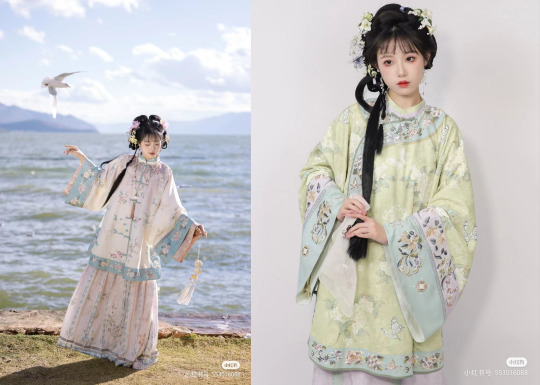
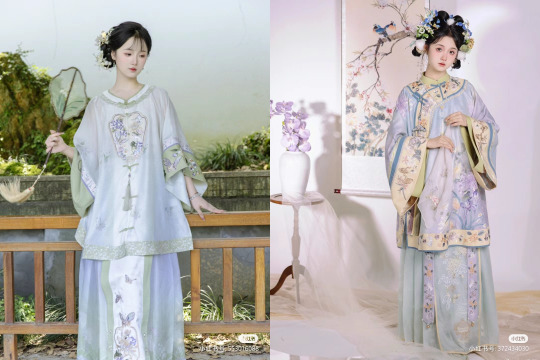
chinese fashion (genre: qinghannv, han women's clothing in qing dynasty)
#china#fashion#chinese fashion#bot asked a hanfu store designer about it and she thinks it's not technically hanfu#it really wasn't qizhuang either#and should be a separate category#so the tag hanfu is not included#i'm not professional about hanfu so#just sharing beautiful chinese clothing#qinghannv
293 notes
·
View notes
Text
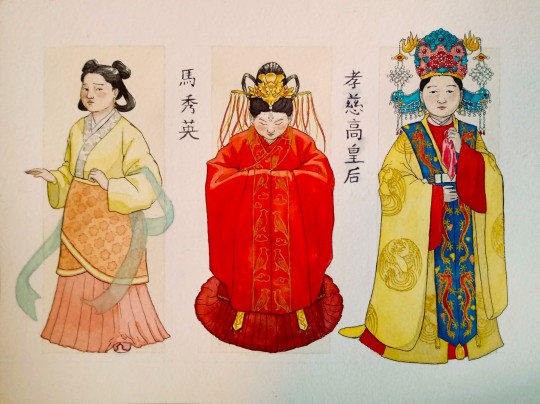
Ma Xiuying from the Radiant Emperor duology!
Design/research notes under the cut
The characters read 馬秀英 (Pinyin: mǎ xiù yīng), her personal name, and 孝慈高皇后 (xiào cí gāo huáng hòu), her name as Empress.
There's certainly no dearth of material on Chinese clothing history out there. That is, if you can read Chinese, which I can't, so everything I have is from secondary and tertiary sources and/or relies on translation software. Fortunately, we're dealing with historical fantasy here, so some anachronisms are not only allowed but encouraged.
While Shelley Parker-Chan takes many liberties, the books are still set in a very specific time period, which is both a blessing and a curse. Most readily accessible resources will tell you about dynasties, which can span hundreds of years, and the duology takes place in a transitional period. So how to dress a Semu girl from the Yuan dynasty who lives with Nanren rebels wanting to revive the Song dynasty and who later becomes the first Ming empress?
Let's go through them one by one. The best resource was this book which is on the Internet Archive. I disregarded Mongol and Semu influences for the design since clothing is very much political and a way to either stand out or fit in with the surrounding society, see for example Wang Baoxiang wearing a topknot in Khanbaliq. Ma, I imagine, would want to fit in with the Nanren around her, so she's pretty much wearing the attire of Han women under Yuan rule. For the hair I went for something that looks youthful while being plausible, though I found very little on hair in this period, so who's to say.
The next one is from a specific scene in the book, so there is some description to go on: red, long sleeves with gold embroidery, high hair, red and gold ribbons. Since this is the scene where Ma declares herself queen and future empress in front of the Red Turban, it has to be a very deliberate dress. It therefore takes inspiration from Song aristocrats' broad-sleeved gowns as well as from 翟衣 (dí yī), the highest ceremonial gown of both Song and Ming empresses. (Some examples for 翟衣 are in this post, which also features the bird shaped crown I just had to include, and this post.) Her hair still has the loops, but it's much more sculpted.
Finally, Empress Ma! This is mainly based on the two actual portraits I could find of the historical figure that Ma is based on, with elements taken from other portraits and paintings. It includes 凤冠 (fèng guān), the phoenix crown, 霞帔 (xiá pèi), the sash, and 禁步 (jīn bù), the jade belt. This video shows how Ming dynasty layers are worn, but it refers to a much later period so it's not quite the same as Ma's.
(Some additional, historically irrelevant notes: I realized too late that a right-to-left timeline might be more appropriate. Oh well! Also, how the colours photograph frustrates me, I swear I did not make her this deathly pale. And finally, some of the characters look a bit smudged because my cat spilled water on them. I did what I could to save them.)
240 notes
·
View notes
Text
[Hanfu · 漢服]Chinese Eastern Han Dynasty (25–220 A.D.) Traditional Clothing Hanfu with Actor Liu Tao/刘涛


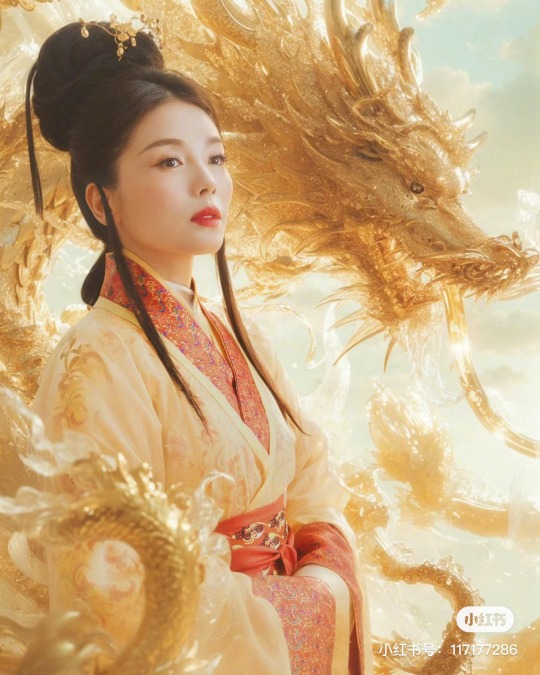
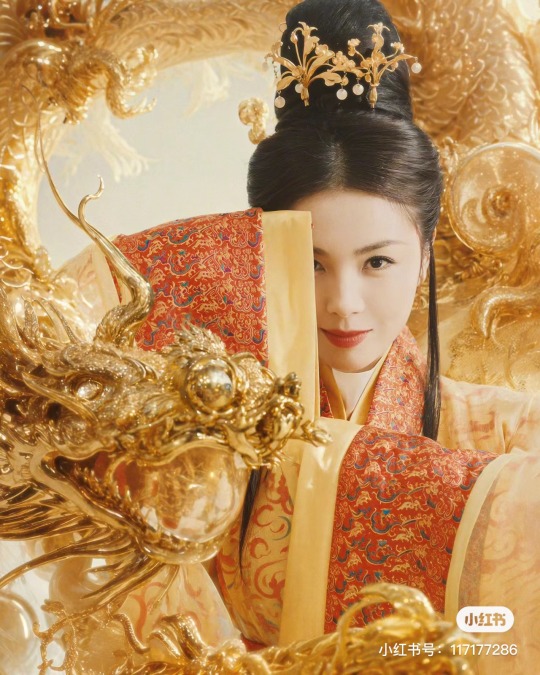



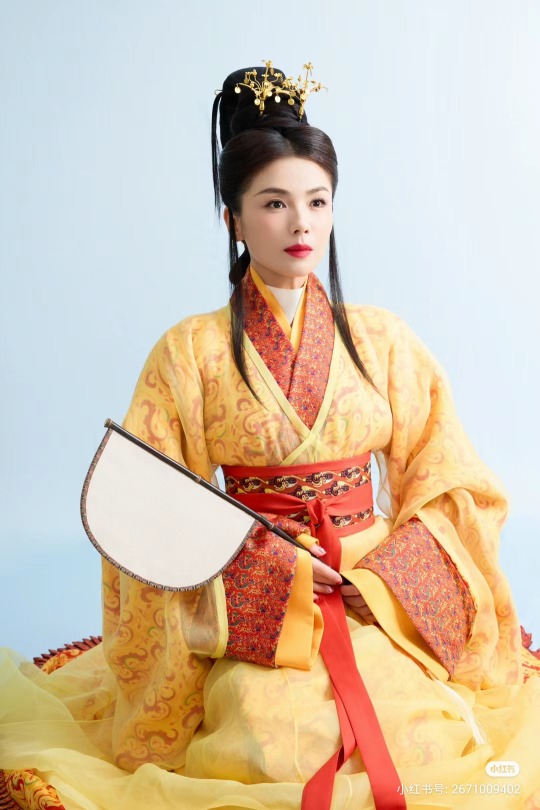

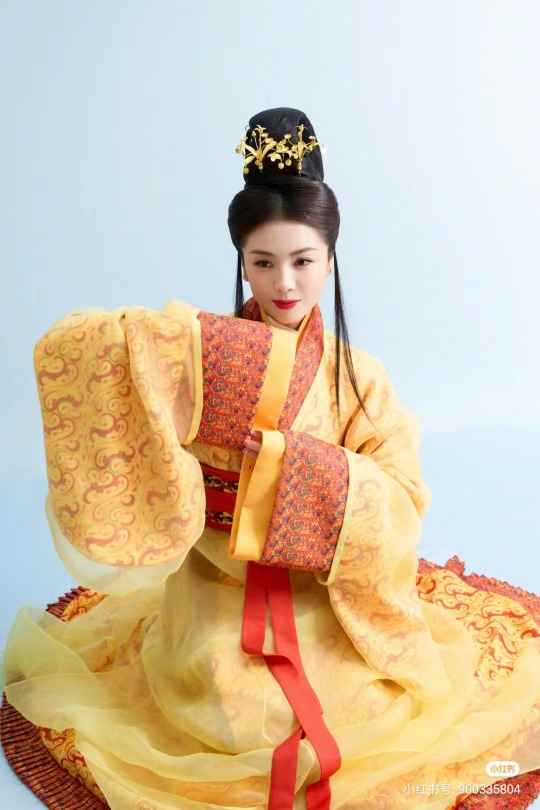

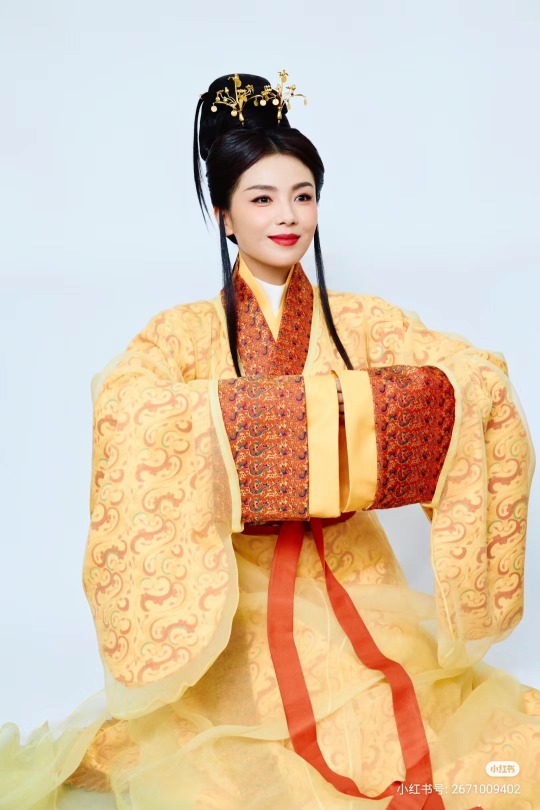
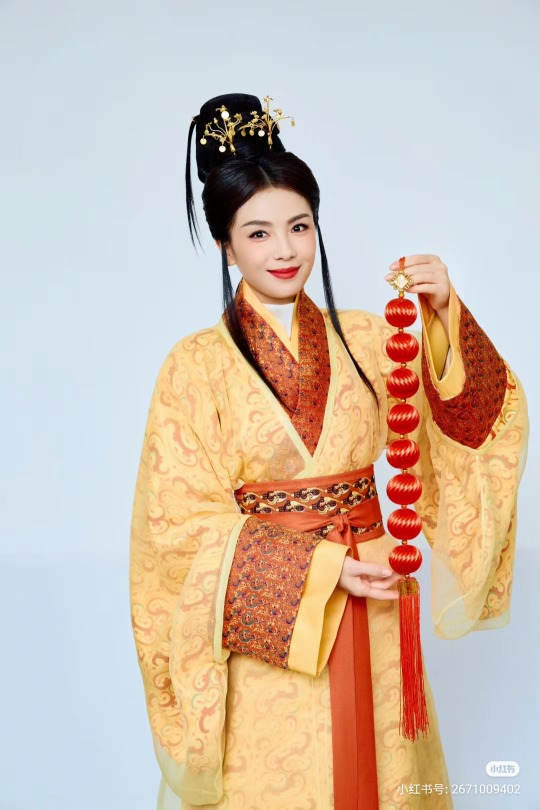


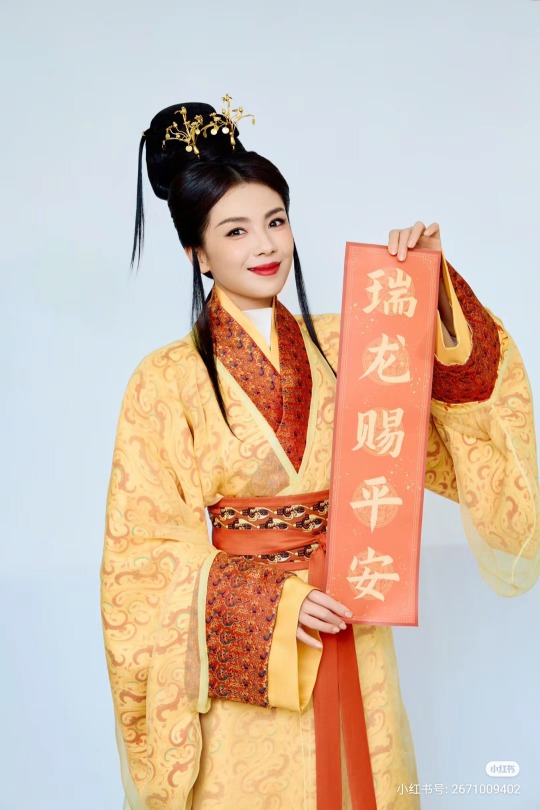
【Historical Artifacts Reference 】:
▶China Han Dynasty Murals<Part of the person holding the halberd and sword>, Luoyang Museum Collection.

▶China Jin Dynasty Painting By Gu Kaizhi (Chinese: 顧愷之,344–406)
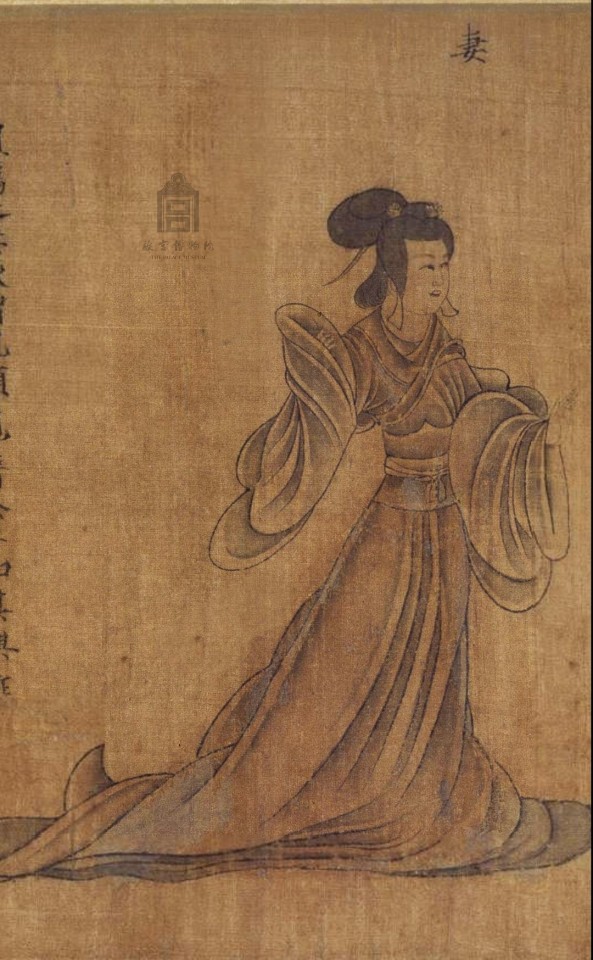

#chinese hanfu#Eastern Han Dynasty (25–220 A.D.)#hanfu#hanfu accessories#hanfu_challenge#chinese traditional clothing#china#chinese#漢服#汉服#中華風#liu tao#chinese fashion#historical fashion#historical hairstyle#chinese style
202 notes
·
View notes
Text
[餘知傳] The 2nd Century Warlord (Part 1)
based on the story by @romanceyourdemons
art by @its-not-a-pen

first day as a second century warlord i have my men tie branches to their horses’ tails to stir up dust and make it look like there’s a lot of us but i forget it just rained so there isn’t any dust and the enemy can clearly see there’s like twenty of us all spread out in a line

second day as a second century warlord i bribe a bunch of kids to start singing a nursery rhyme i carefully crafted to spread misinformation and further my strategic ends but they change the lyrics to be about poop and the enemy isn’t misdirected at all
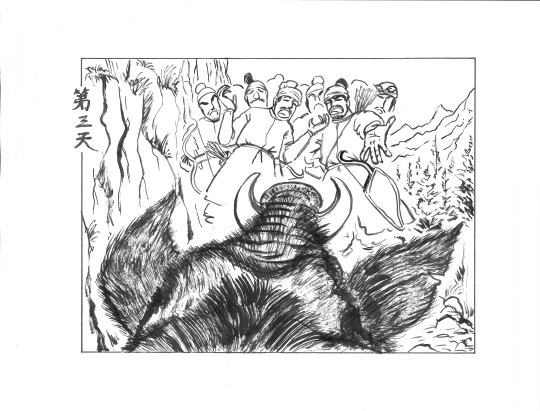
third day as a second century warlord i lure my enemy into a narrow valley and send a team of archers to shoot them from the high ground but there was a feral hog napping on the trail up to the overlook and they couldn’t decide whether to try and shoot it or just go around and by the time the hog woke up and left on its own the enemy had already passed safely below
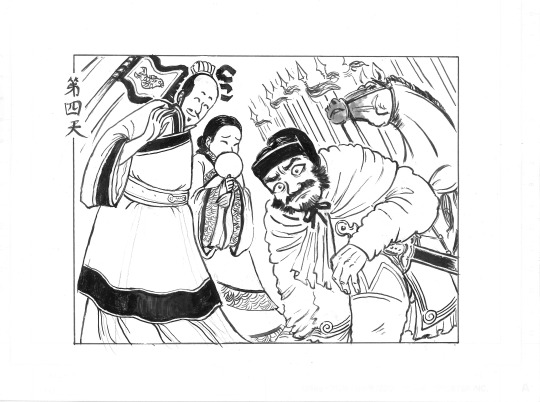
fourth day as a second century warlord we attempt to join a battle on the side of the guy we want to ally with but he and the guy he’s fighting have really similar names and it’s finally dusty and i misread the standards and attack the wrong guy. so now we’re stuck with this total loser of a liege lord, because how the fuck do you explain that after a battle?

fifth day as a second century warlord and some sort of wizard wanders into camp, my loser liege lord wants to execute him for being a wizard but i convince him to let the wizard stay, because i want to do more weather-based strategies and i’m pretty sure having a camp wizard can help with that. after the welcome to the team banquet the wizard steals half the treasury and my liege lord’s wife and leaves
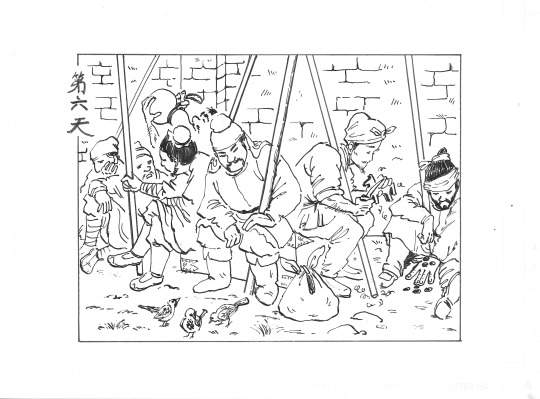
sixth day as a second century warlord my loser liege lord sends me to reinforce a city he’s taken, but in the confusion of leaving i forgot to take the token that would have gotten us into the city, so my men have to wait outside the city walls for like eight hours while i ride back to get it
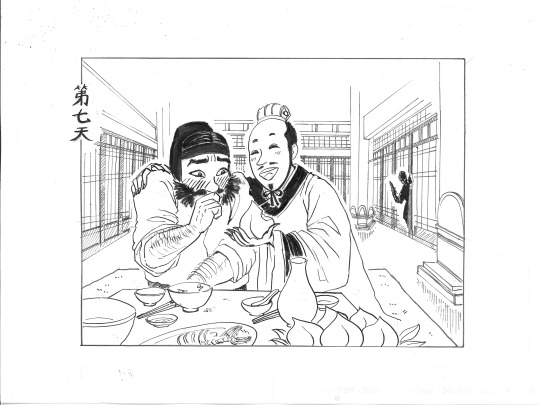
seventh day as a second century warlord and my loser liege lord finally joins me in the city, it turns out he’s actually a pretty cool guy, and he isn’t even that mad at me for letting the wizard steal his wife. i decide to shoot my shot but i’m really nervous and keep on stalling because what if i mess up our relationship and by extension jeopardize the security of my men, and eventually he just says goodnight and goes back to his room, where an assassin is in the process of setting up to kill him
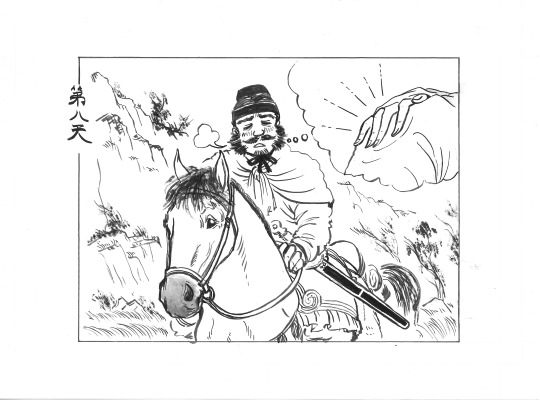
eighth day as a second century warlord and my loser liege lord tells me to fake defect to his rival warlord, the one i originally wanted to ally with, to find out if he was the one who sent the assassin and why. but my whole way over to the rival warlord i’m worried that this has something to do with the wizard thing or how awkward i made it last night
End of Part 1
This comic was made independently from the creator, I'm just a fan and these are my own interpretations.
Notes under the cut:
the title 餘知傳 [the Story of Yu Zhi], is the styled name of the Second Century Warlord. I translated 餘知 as [plentiful knowledge] since he's defined by a surplus of knowledge but a deficit in luck. It's also great for fish-based puns since it's a homophone. As a nice parallel, Loser Liege Lord's banner is a carp ;))). the art style was inspired by vintage Chinese comics.

The story is set during the Three Kingdoms period, (220 to 280 AD) natural disasters, infighting and civil unrest had dissolved the previous Han Dynasty, leading to a violent free-for-all. I based the clothes on the previous Eastern Han styles, mainly because there just weren't a lot of contemporary references from the 3K period (and it only lasted like, 60 years). I always strive for historical accuracy, however, the Han Dynasty was over 400 years long and some sources don't do a great job separating out the different fashions, so I apologise for any mistakes that occur.
2. there aren't a ton of drawings on what Han children looked like, but in general ancient kids hairstyles are pretty consistent. 9-15 yo boys had shaved heads with two little top knots, girls had natural hair in braids/buns.
3. the crossbow (back left) makes a cameo, it was associated with Zhuge Liang, famous real-life strategist from the 3K era.
4. the LLL and his wife thank the Warlord, (a noblewoman on a battlefield??? scandalous!). it shows the LLL enjoys the unconventional and the wife is not as timid as she appears. I thought it would be funny to make them look as Background Character (tm) as possible.
5. I based the wizard's design on sages from mythology. (Hey, he's not a total fraud, he invented gunpowder 800 years before the Tang dynasty!) Nice little character moment for the LLL who is shielding his wife.
6. What do soldiers do while they're waiting for 8 hours? (<-from the right) playing knucklebones with pebbles, whittling a little horse, feeding sparrows, gossiping with neighbour, drinking from his gourd, napping. A minor warlord can't afford to keep a professional army so they're most likely conscripted farmers who've had to buy their own weapons and armour, hence why they look so unimpressive.
7. LLL offers the Warlord a bitten peach. Inspired by the legend of Mizi Xia who bit into a delicious peach and gave it to the Emperor so he could taste it was well. "Bitten peach" was a byword for homosexuality in ancient China. I thought it would be SO funny if the LLL was actually smooth af and the Warlord was a like a teenaged girl crushing for the first time. He's desperate to taste that peach but is too timid to reach out >;))) man has zero game. negative game, even. truely the PS4 of homosexuals. RIP to the assassin in the back corner who was forced to watch the most awkward, cringe-fail attempt at flirting in the history of china play out.
8. this is what zero peach does to a mf. UnU
#ink drawing#comics#second century warlord#original art#ancient china#op if ur reading this im a huge fan and i love ur work#storytime#tumblr stories#history memes#romance of the three kingdoms
2K notes
·
View notes
Text

The Wall's Monochromatic Girl Gang. I was going to make a joke about what, exactly, they're talking about, but... I shan't.
A few notes:
• Isn't if fun how they're dressed for the same weather? Melisandre's outfit is inspired in this one Hanfu I keep seeing on Pinterest, though I don't know which dynasty it's inspired by. Han? Anyway Asshai is further east from Yi Ti, so chinese inspiration makes sense for me. (In terms of historical accuracy, we would be wearing Ming Dynasty inspired clothes, which is what I imagine for northern Yi Ti tbh). Beware the Arcane Asshai'i magicks of the Ye Olde Push Up Bra.
• I've been bouncing back and forth with Inuit-inspired or Siberian-inspired clothes for the Free-folk. Siberian/Eastern Russian clothes makes more sense in terms of the Slavic-inspired North continuity, but I guess I seeing too much of these giant baby-carrying Inuit hoodies and thought they looked fun. Val uses it to carry Gilly's baby on. occasion. It was originally meant to be a gift for Dalla.
• Val is actually pretty tall, Melisandre is just like. A giant. Originally Val was blushing (because of the cold) but that got weirdly romantic and I cannot handle shipping Mel with anyone other than Selyse, so yeah. Also afaik we don't have any indication that Val is a spearwife, but I wanted her to hold something, so she can at least carry a spear around. Is a free folk spear supposed to be this size? This question will haunt me for eternity.
#melisandre#val#val asoiaf#asoiaf#a song of ice and fire#Valyrianscrolls#asoiaf fanart#my art#sun o' mine#adwd
177 notes
·
View notes
Text
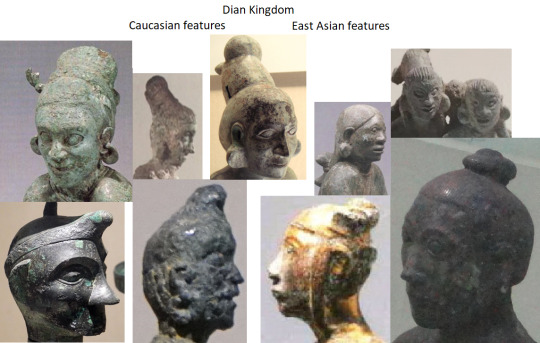

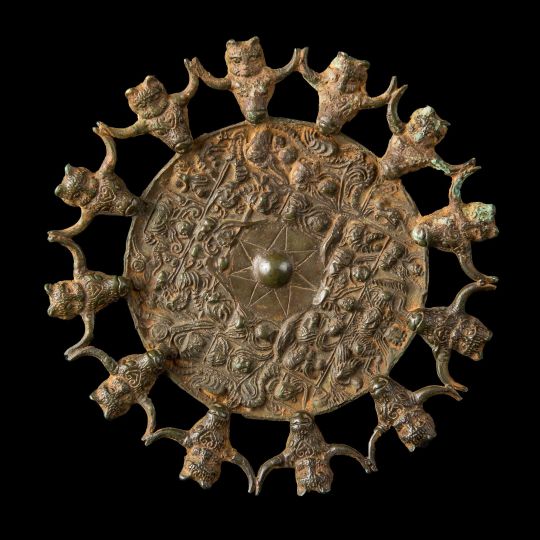
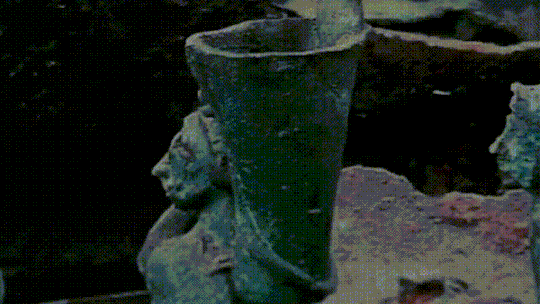

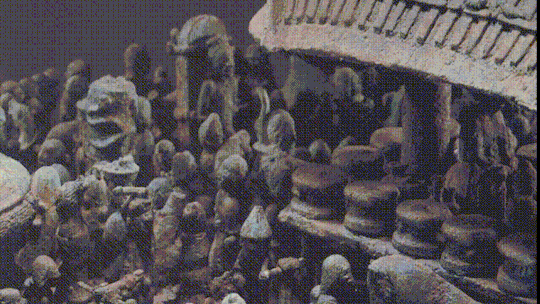

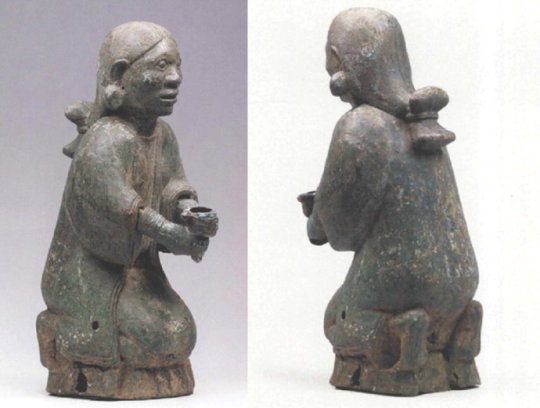

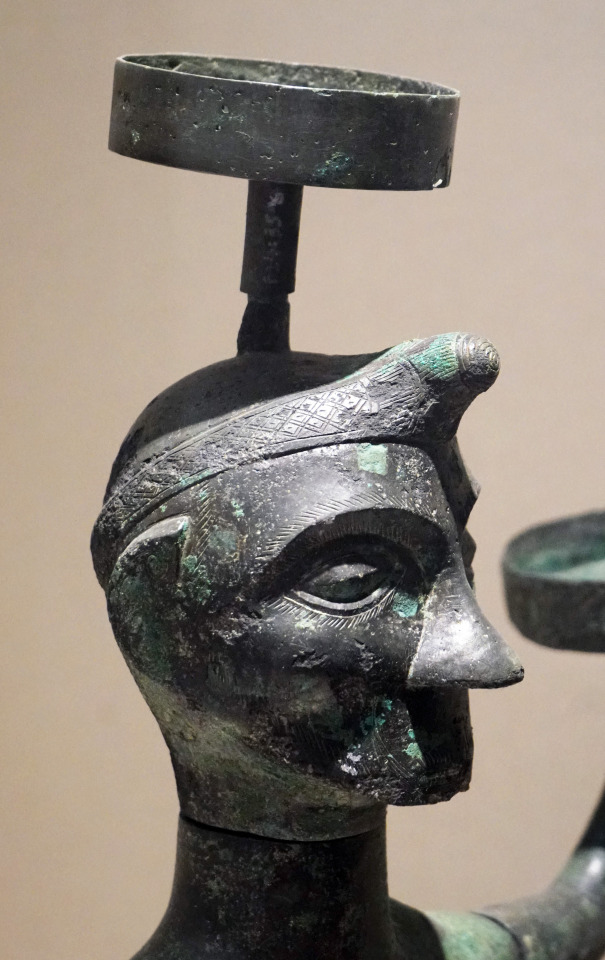

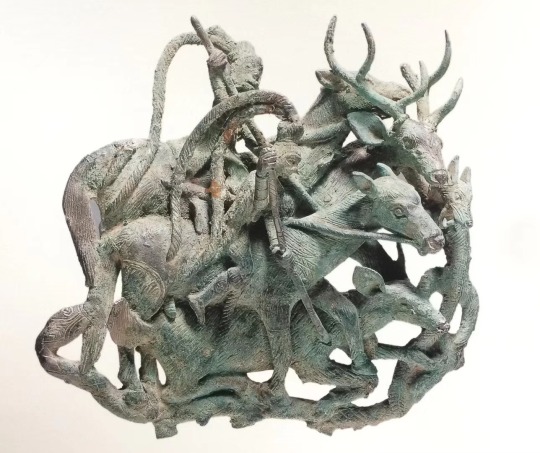





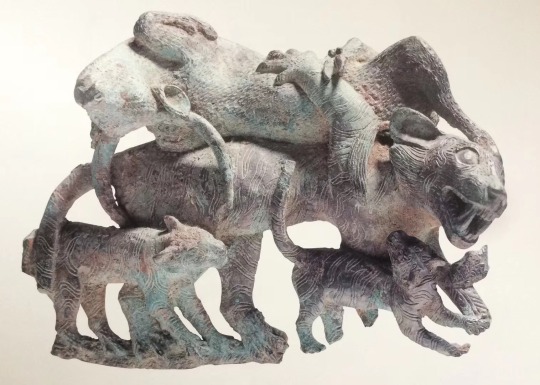

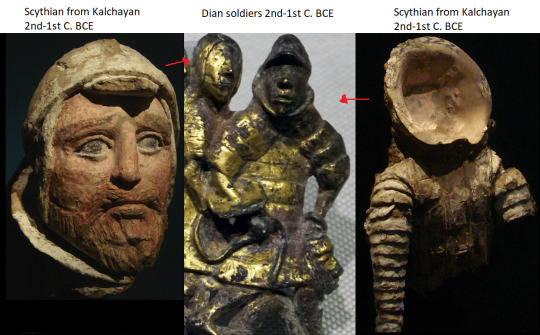
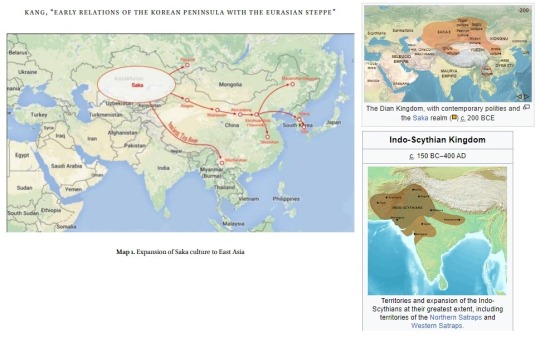


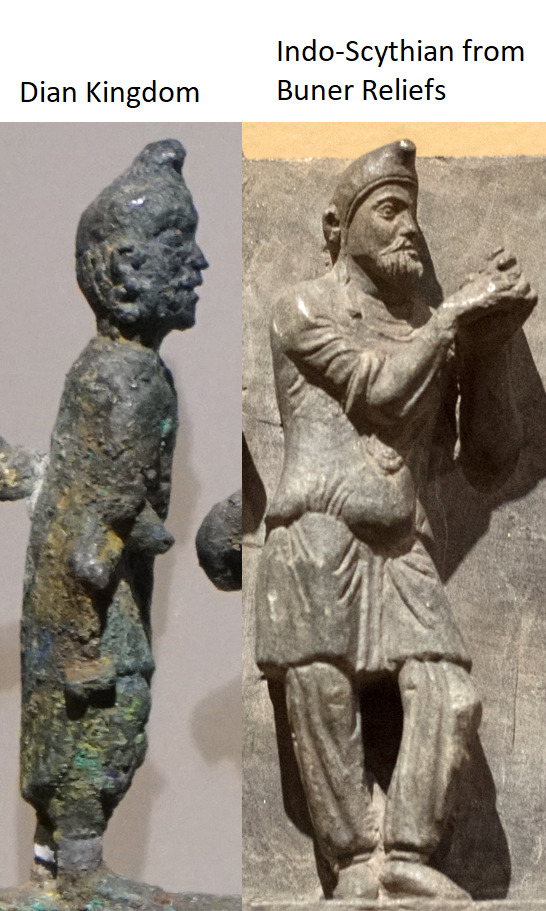


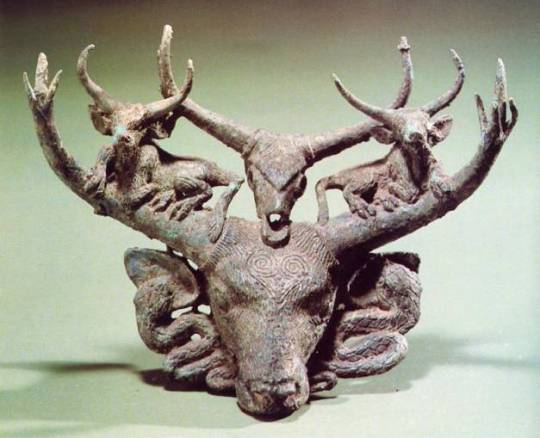
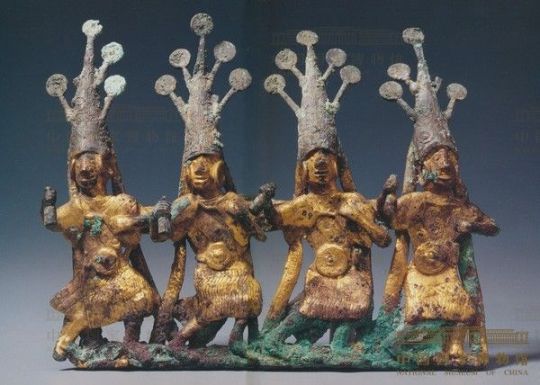

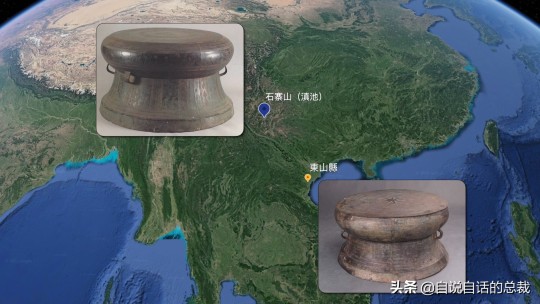
Dian Kingdom 8th-1st C. BCE. Meant to post this one a long time ago but it took me forever to put together. I'm just going to post 30 images here, I got about 100 total on my blog. Link at bottom.
The Dian Kingdom was an advanced civilization in what is modern-day southwest China. It was occupied by the Han Dynasty and incorporated into China after that. From what I've gathered, the people of the Dian Kingdom were probably closely related to the Baiyue people from southern China and northern Vietnam. Wikipedia says they may have spoke a Tibeto-Burman language. I found it interesting that some of these people look Caucasoid though and were wearing clothing similar to Scythians. The image I compared of the Dian man to the Indo-Scythian has a similar facial structure, hat, and even the same type of pants (sorry, I don't have time to tidy up the comparison photos more).
The Dian art theme of the four tigers attacking an ox is found in the same pre-Han period among the Xiongnu at Aluchaideng, and a similar motif appears at Tillya Tepe a couple centuries later. The theme is the same but the style is very different, still it indicates a connection to these places of the world through trade and exposure.
Some of the scenes with soldiers show a variety of different equipment styles and certain subjects have distinct fashion styles (like the people wearing the items that make their ears look huge). I watched a couple documentaries on genetics of the Dian and they were only able to find genetic info for one person, who was identified as similar to the Baiyue people. I'll link those youtube videos in sources below. I assume these people were primarily related to modern day Vietnamese and southern Chinese (or other people nearby) but may have had close interactions with (and even immigrants from) Scythian cultures despite their distance from them, which is interesting.
From the videos: "According to the final count, the amount of bronze ware excavated from Lijia Mountain is almost half the amount of the Shang Dynasty bronze ware excavated in Yinxu, Henan."
youtube
youtube
#ancient history#history#museums#art history#art#sculpture#statue#ancient china#china#vietnam#scythian#artifacts#antiquities#anthropology#archaeology#indo european#Youtube
264 notes
·
View notes
Text
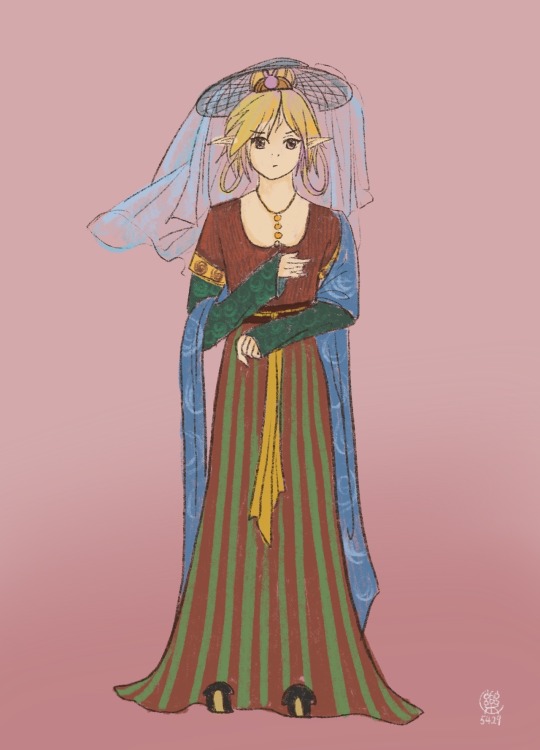
If Legend wears Hanfu…
Traditional clothing worn by the ethnic Han Chinese
References are used for the pose and historical costume.
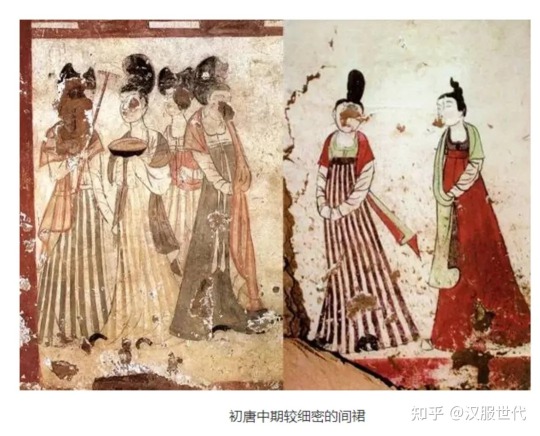
63 notes
·
View notes